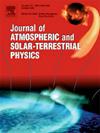Impact of climatic factors on volume aerosol size distribution over Northern India
IF 1.9
4区 地球科学
Q3 GEOCHEMISTRY & GEOPHYSICS
Journal of Atmospheric and Solar-Terrestrial Physics
Pub Date : 2025-09-15
DOI:10.1016/j.jastp.2025.106633
引用次数: 0
Abstract
The correlation between climatic factors and the volume aerosol size distribution (V-ASD), which was extracted from AERONET data for 5 years at five monitoring sites throughout Northern India, has been investigated. Fine-mode aerosols (<0.58 μm) showed negative correlations with rainfall (RF) and relative humidity (RH), where RH enhances hygroscopic growth, making particles more prone to removal by precipitation scavenging. Depending on the station, the correlation between Wind Speed (WS) and V-ASD varied. The pre-monsoon period was marked by greater WS and Boundary Layer Height, which improved aerosol dispersion and mixing, but the monsoon period (June–September) regularly raised RF and RH, according to seasonal changes. At most sites, coarse-mode aerosols (>0.58 μm) showed a positive correlation with temperature, whereas fine-mode particles showed negative correlations with both temperature and relative humidity. Coarse particle development was greatly impacted by temperature-driven processes, especially at Gandhi College and Kanpur. These results demonstrate the intricate relationships that exist in North India between regional climatic factors and aerosol size distributions.
气候因子对印度北部气溶胶体积大小分布的影响
从印度北部5个监测点的AERONET数据中提取了5年的气溶胶体积大小分布(V-ASD),研究了气候因子与气溶胶体积大小分布之间的相关性。细模气溶胶(<0.58 μm)与降雨量(RF)和相对湿度(RH)呈负相关,其中相对湿度增强吸湿性生长,使颗粒更容易被降水清除。风速(WS)与V-ASD之间的相关性因气象站的不同而不同。季风前期WS和边界层高度增大,有利于气溶胶的扩散和混合,但季风期(6 - 9月)根据季节变化,RF和RH有规律地升高。在大多数站点,粗模态气溶胶(>0.58 μm)与温度呈正相关,而细模态气溶胶与温度和相对湿度均呈负相关。粗颗粒的发育很大程度上受到温度驱动过程的影响,特别是在甘地学院和坎普尔。这些结果表明,在印度北部,区域气候因子与气溶胶大小分布之间存在着复杂的关系。
本文章由计算机程序翻译,如有差异,请以英文原文为准。
求助全文
约1分钟内获得全文
求助全文
来源期刊

Journal of Atmospheric and Solar-Terrestrial Physics
地学-地球化学与地球物理
CiteScore
4.10
自引率
5.30%
发文量
95
审稿时长
6 months
期刊介绍:
The Journal of Atmospheric and Solar-Terrestrial Physics (JASTP) is an international journal concerned with the inter-disciplinary science of the Earth''s atmospheric and space environment, especially the highly varied and highly variable physical phenomena that occur in this natural laboratory and the processes that couple them.
The journal covers the physical processes operating in the troposphere, stratosphere, mesosphere, thermosphere, ionosphere, magnetosphere, the Sun, interplanetary medium, and heliosphere. Phenomena occurring in other "spheres", solar influences on climate, and supporting laboratory measurements are also considered. The journal deals especially with the coupling between the different regions.
Solar flares, coronal mass ejections, and other energetic events on the Sun create interesting and important perturbations in the near-Earth space environment. The physics of such "space weather" is central to the Journal of Atmospheric and Solar-Terrestrial Physics and the journal welcomes papers that lead in the direction of a predictive understanding of the coupled system. Regarding the upper atmosphere, the subjects of aeronomy, geomagnetism and geoelectricity, auroral phenomena, radio wave propagation, and plasma instabilities, are examples within the broad field of solar-terrestrial physics which emphasise the energy exchange between the solar wind, the magnetospheric and ionospheric plasmas, and the neutral gas. In the lower atmosphere, topics covered range from mesoscale to global scale dynamics, to atmospheric electricity, lightning and its effects, and to anthropogenic changes.
 求助内容:
求助内容: 应助结果提醒方式:
应助结果提醒方式:


